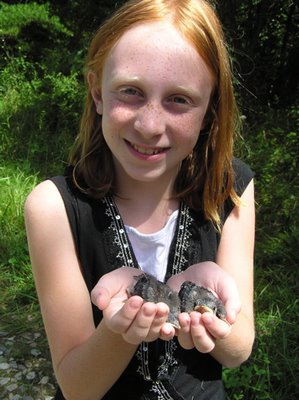
There they are, the last two bluebirds of the season to fledge on our place, a photo taken August 18. Three more fledged a few days after that from a box on Stanleyville Road. And thus ends the bluebird breeding season. It was a good one, my best yet, but only by virtue of having put up more boxes this year. One thing I've found out is that I'm at the upper limit of boxes that I can expect to monitor. We've got 15 on our place and another 8 spread out Stanleyville Road. That may not sound like a lot, but try getting to each and every one at least once a week, and you begin to realize that 23 boxes is a lot.
It was kind of a weird year. I had two bluebird nests predated by snakes (despite the extreme baffles), and three instances of suspected herbicide poisoning. The snakes got eight babies, while the herbicides are suspected of killing 15. This is the first year I've had problems with herbicides. I try not to think how many bluebirds would have fledged without them.
Not to emphasize the negative, though; it was a heck of a year! Drum roll, please:
From our 15 boxes on Indigo Hill, 3 tree swallows, 10 Carolina chickadees, and 69 eastern bluebirds fledged! Whoop and holler!
Seven Carolina wrens fledged from the little copper bucket by our door. Yess!
In all the 23 boxes, we fledged a total of 13 tree swallows, 10 Carolina chickadees, and a whopping 90 eastern bluebirds!
I'm not counting an additional four boxes that Jeff Warren put up on a lovely bit of land that I just couldn't get to often enough to monitor. I know that three of the boxes fledged bluebirds and one fledged chickadees, but don't know how many. Somebody needs to keep track of those.
I'm especially proud of these numbers because they reflect intensive bluebird farming techniques: predator baffling, feeding intervention in bad weather, box relocation when necessary, nest changes so blowflies and mites don't take over, cross-fostering --anything to up the totals and help the maximum number of healthy fledglings out into the world.
A highlight of the year was my first double brood of tree swallows, in Sue the bus driver's backyard no less. The first brood of six! fledged in the third week of May; the second brood of four from the same pair in the same box fledged around July 26. This is the first double tree swallow brood I've ever seen, although I've heard that double-brooding has begun occurring in the newly colonized areas of North Carolina and Georgia. Tree swallows are moving south, and adjusting their breeding phenology to the longer season. I'd always considered them obligate single-brooders, but that picture is changing. I'm just beside myself to have witnessed it as far north as southern Ohio. The world needs more tree swallows, and I am happy to be providing them a place to raise their young.
Here, I'll refrain from speculating that global warming is the cause of range expansion and double brooding in tree swallows. I prefer to think of this as a nice thing. If that makes me a Pollyanna, well, OK, but I'm a Pollyanna who does more than just sit around adjusting her hairbows.
So any time you wonder how you can make the world a nicer place, consider starting a bluebird trail. It can be hard work, and sometimes heartbreaking, but counting your fledglings at years' end, and seeing them lining up on the phone wires in autumn, is better than counting anything else I can think of. Or adjusting your hairbows.






0 comments:
Post a Comment